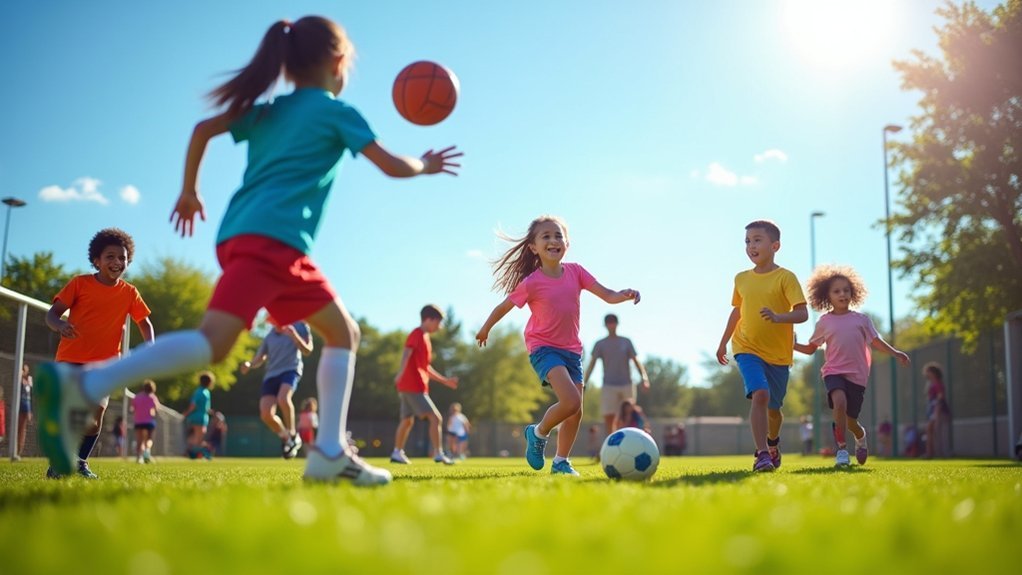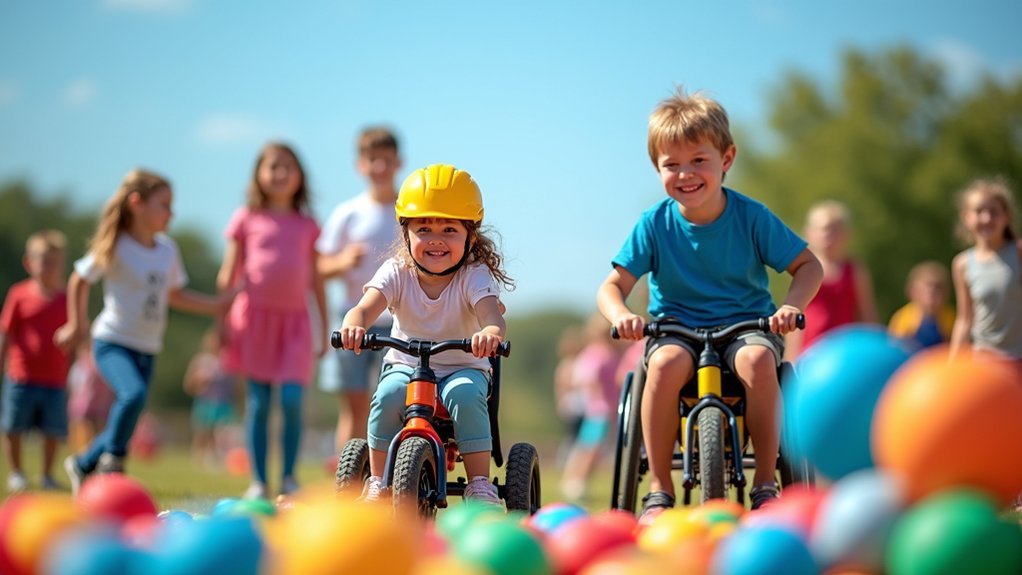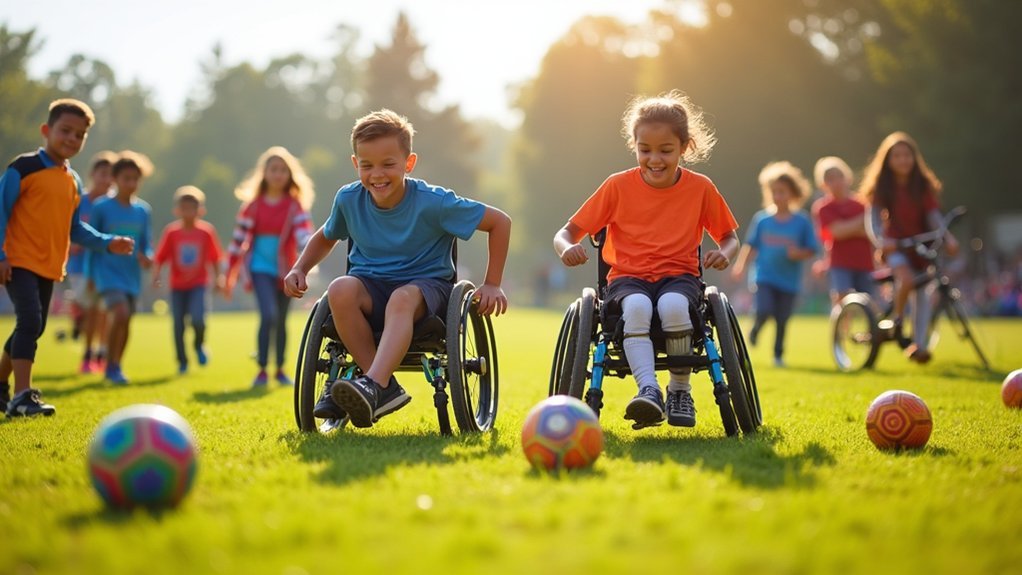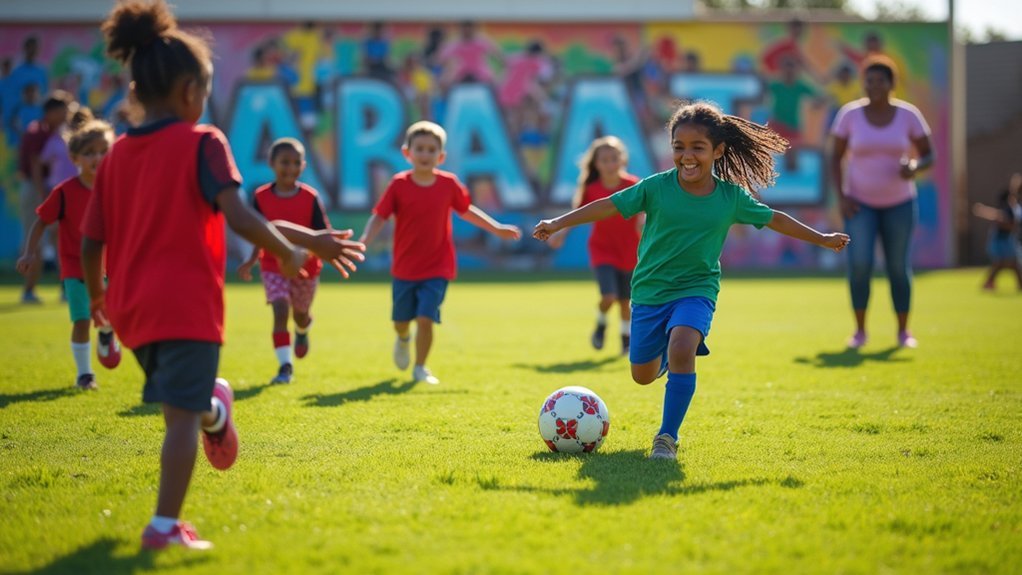Sports equity means every child deserves access to outdoor activities regardless of income, ability, or background. You’ll find that inclusive spaces with adaptive equipment and sensory-friendly environments allow all children to participate fully. When coaches receive proper training for neurodiversity and physical adaptations, they create supportive atmospheres where diverse children build confidence and strong community ties. Breaking down barriers—from economic obstacles to accessibility challenges—transforms participation rates and guarantees every child can experience the joy of outdoor play.
Second-Level Headings for “Why Every Child Belongs Outside: Sports Equity”

While sports participation offers tremendous benefits for youth development, significant inequities prevent many children from accessing these opportunities. The 16-25% participation gap between low-income and higher-income youth reveals how economic barriers limit access to sport, particularly affecting marginalized communities.
The dramatic decline in BIPOC representation—exemplified by Oakland’s Babe Ruth League dropping from 92% to 40% Black participation—signals systemic issues requiring urgent attention. Young people from communities of color, especially girls, face compounded obstacles including higher dropout rates and fewer role models.
The alarming erosion of BIPOC participation in youth sports reveals deeply entrenched inequities demanding immediate systemic solutions.
True sports equity requires collaborative approaches like the Positive Coaching Alliance’s initiative, which engages local stakeholders to create inclusive environments.
When we remove barriers to participation, we help foster the sense of belonging that 74% of children experience in sports clubs, supporting their complete development.
Breaking Barriers: Creating Accessible Outdoor Spaces for All Abilities
Although every child deserves outdoor play opportunities, many face significant access barriers due to physical or cognitive differences.
Children with disabilities participate less in sports and outdoor activities, often due to inaccessible facilities and lack of adaptive equipment.
You’ll find that investing in accessible outdoor spaces directly promotes sports equity.
When you design inclusive environments using universal design principles, you’re enabling children of all abilities to play alongside peers, fostering essential social connections and belonging.
Without these spaces, isolation and exclusion feelings intensify among disabled children.
Your community’s commitment to adaptive playgrounds and accessible sports fields isn’t just about physical activity—it’s about creating equal opportunities for every child to experience the joy of outdoor play, regardless of their abilities.
Sensory-Friendly Sports: Adapting Activities for Diverse Needs

You’ll find that minimizing sensory overwhelm requires thoughtful planning, such as scheduling activities during quieter times and providing visual schedules to prepare children for changes.
Adaptive equipment solutions, including softer balls, noise-dampening headphones, and textured grip aids, enable children with diverse sensory needs to participate comfortably in sports they might otherwise avoid.
Creating noise-reduced play spaces with designated quiet zones, dimmer lighting options, and reduced echo environments allows all children to engage in physical activities without experiencing sensory overload.
Minimizing Sensory Overwhelm
How can sports environments become more accessible to children with sensory sensitivities? Start by creating quieter spaces where young athletes can participate without feeling overwhelmed.
You’ll find that structured, sensory-friendly environments greatly increase participation rates among neurodiverse children.
Modify your approach by incorporating flexible rules and individualized coaching strategies to accommodate diverse needs. Using softer balls or running slower-paced games reduces sensory overload while maintaining the sport’s core elements.
Visual supports provide clear expectations, helping children navigate activities with greater confidence.
Don’t overlook coach training—equip your staff with sensory awareness techniques and inclusion strategies.
Adaptive Equipment Solutions
When designed thoughtfully, adaptive equipment transforms sports participation for children with sensory sensitivities and diverse needs.
You’ll find that lightweight balls, textured surfaces, and adjustable gear greatly boost participation rates among children who might otherwise remain sidelined. Research confirms that these inclusive sports approaches not only enhance physical development but also nurture essential social connections.
- Sensory-friendly equipment with varied textures, weights, and sizes accommodates different processing needs
- Adjustable features like removable parts or modifiable resistance levels let children customize their experience
- Community organizations offering specialized equipment libraries create access points for families with limited resources
Noise-Reduced Play Spaces
Noise-reduced environments represent the next frontier in creating truly accessible sports experiences for all children.
When you establish sensory-friendly play spaces, you’re addressing a significant equity gap that disproportionately affects communities of color, where sensory processing disorders often go undiagnosed.
These adapted environments—featuring quieter equipment, visual boundaries, and structured routines—dramatically reduce anxiety and improve focus for neurodiverse youth.
You’ll notice immediate improvements in sport participation as children who previously avoided physical activities begin to engage confidently.
Creating these spaces isn’t just about accommodation; it’s about social justice.
The Power of Adaptive Equipment in Leveling the Playing Field

While traditional sports often exclude children with disabilities due to physical barriers, adaptive equipment has emerged as a game-changer in creating truly inclusive athletic environments.
When you provide specialized wheelchairs, prosthetics, and modified gear, you’re not just enabling participation—you’re transforming lives. Studies confirm that access to adaptive equipment dramatically increases participation rates among children with disabilities, supporting both physical development and mental health.
- Organizations dedicated to the equity movement help overcome financial barriers by providing funding for equipment.
- Adaptive equipment fosters inclusivity by allowing children of all abilities to participate alongside their peers.
- Beyond physical benefits, these tools build confidence and create a sense of belonging in the sports community.
You’ll witness remarkable growth when children with disabilities access the right equipment to showcase their abilities.
Building Communities Through Inclusive Recreation Programs
You’ll find inclusive recreation programs are essential bridges connecting youth from all backgrounds through sports participation.
These initiatives work to close the significant 16-25% participation gap between low and higher-income children by removing systemic barriers that limit BIPOC youth involvement.
When programs like the Positive Coaching Alliance’s Sports Equity Initiative bring stakeholders together, they create environments where diverse children develop strong community bonds—evidenced by the 74% of youth who report feeling a sense of belonging in their sports clubs.
Breaking Participation Barriers
Despite decades of advocacy, systemic inequities continue to exclude millions of children from sports participation, particularly those from low-income and BIPOC communities.
Young people face participation gaps of 16-25% when comparing low-income families to higher-income peers, with systemic barriers like pay-to-play fees preventing many from accessing opportunities to play sports.
The decline is particularly alarming in communities of color—Oakland’s Babe Ruth League dropped from 1,200 to just 250 players over three decades.
To create equitable access, we must:
- Remove financial barriers through community-based funding solutions
- Create collaborative interventions between schools and local organizations
- Prioritize representation for girls and women of color who face unique participation challenges
These targeted approaches can help close the opportunity gap and guarantee all children benefit from sports participation.
Connecting Diverse Youth
When you create inclusive recreation programs, you’re not just offering sports—you’re building social bridges across communities.
The Play Equity Fund demonstrates how targeted initiatives can connect BIPOC youth who participate at lower rates than their white peers. These connections matter: 74% of children report a strong sense of belonging at their sports clubs, highlighting how a positive sports experience transcends physical activity.
Meaningful change happens when programs intentionally engage underrepresented groups, especially girls and women of color who face unique barriers.
Organizations like the Positive Coaching Alliance show that community-based interventions can transform participation rates while enhancing social cohesion.
Training Coaches for Neurodiversity and Physical Adaptations
The modern sports environment demands coaches who can effectively support athletes of all neurological and physical abilities. When you invest in training coaches about neurodiversity, you create inclusive coaching environments where all children thrive.
Today’s athletes deserve coaches trained in neurodiversity—creating spaces where every player’s unique abilities become their greatest strengths.
Evidence confirms that these practices not only boost participation among neurodiverse youth but strengthen team dynamics and peer relationships.
- Implement modified equipment and tailored activities to guarantee physical adaptations meet diverse ability needs
- Establish regular assessment systems that help coaches adjust strategies based on individual progress
- Create supportive atmospheres that build confidence in athletes with different neurological processing styles
Frequently Asked Questions
Why Does Equity Matter in Youth Sports?
Equity matters in youth sports because it guarantees you’ve got fair access regardless of background. You’ll develop confidence, teamwork skills, and physical health when systemic barriers don’t prevent your participation based on income, race, or gender.
What Are the Equity Issues in Sports?
You’ll find major equity issues in sports include financial barriers for low-income families, racial disparities affecting BIPOC youth, gender inequities impacting girls, especially girls of color, and systemic “pay-to-play” obstacles limiting participation opportunities.
What Is the Most Common Reason Why Children Drop Out of Sports?
You’ll find that pressure to perform and the focus on competition over enjoyment is the most common reason children quit sports. Studies show 70% drop out by age 13 due to this issue.
What Percent of Parents Put Their Kids in Sports?
According to the study, approximately 60% of parents enroll their children in sports programs. You’ll find this participation rate varies considerably based on family income levels, with higher-income families showing greater enrollment rates.
In Summary
You’ve seen how inclusive outdoor sports transform lives. By creating accessible spaces, adapting activities, providing proper equipment, building supportive communities, and training informed coaches, you’re helping every child discover their potential. When you champion sports equity, you’re not just promoting physical activity—you’re cultivating belonging, confidence, and joy. Remember, a child who feels included today becomes tomorrow’s advocate for equity.





Leave a Reply